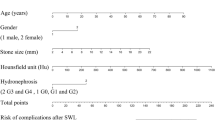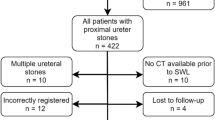Abstract
Purpose
To develop and validate a nomogram for predicting stone-free failure after shock wave lithotripsy (SWL) guided by ultrasound in patients with ureteral stones.
Methods
The development cohort consisted of 1698 patients who underwent SWL guided by ultrasound at our center from June 2020 through August 2021. Multivariate unconditional logistic regression analysis was used for building a predictive nomogram with regression coefficients. An independent validation cohort consisted of 712 consecutive patients from September 2020 through April 2021. The performance of the predictive model was assessed in regard to discrimination, calibration, and clinical usefulness.
Results
Predictors of stone-free failure included distal stone location (odds ratio = 1.540, P < 0.001), larger stone size (odds ratio = 1.722, P < 0.001), higher stone density (odds ratio = 1.722, P < 0.001), larger skin to stone distance (SSD) (odds ratio = 1.058, P < 0.001), and higher grade of hydronephrosis (odds ratio = 1.755, P = 0.010). For the validation cohort, the model showed good discrimination with an area under the receiver operating characteristic curve of 0.925 (95% confidence interval, 0.898, 0.953) and good calibration (unreliability test, P = 0.412). Decision curve analysis demonstrated that the model was also clinically useful.
Conclusions
This study demonstrated that stone location, stone size, stone density, SSD, and hydronephrosis grade were significant predictors of stone-free failure after SWL guided by ultrasound in patients with ureteral stones. This may guide clinical practice.

Similar content being viewed by others
Data availability
Not applicable.
References
Trinchieri A et al (2003) Epidemiology. In: Segura JW, Pak CY, Preminger GM, Tolley D (eds) Stone disease. Health Publications, Paris
Zhe M et al (2017) Nephrolithiasis as a risk factor of chronic kidney disease: a meta-analysis of cohort studies with 4,770,691 participants. Urolithiasis 45:441. https://doi.org/10.1007/s00240-016-0938-x
Assimos D, Krambeck A, Miller NL et al (2016) Surgical management of stones: American Urological Association/Endourological Society Guideline, PART II. J Urol 196:1161–1169. https://doi.org/10.1016/j.juro.2016.05.091
EAU. https://uroweb.org/guidelines/urolithiasis/chapter/guidelines
Do MT, Ly TH, Choi MJ, Cho SY (2022) Clinical application of the therapeutic ultrasound in urologic disease: Part II of therapeutic ultrasound in urology. Investig Clin Urol 63:394–406. https://doi.org/10.4111/icu.20220060
Wiesenthal JD, Ghiculete D, Ray AA, Honey RJ, Pace KT (2011) A clinical nomogram to predict the successful shock wave lithotripsy of renal and ureteral calculi. J Urol 186:556–562. https://doi.org/10.1016/j.juro.2011.03.109
Niwa N, Matsumoto K, Miyahara M et al (2017) Simple and practical nomograms for predicting the stone-free rate after shock wave lithotripsy in patients with a solitary upper ureteral stone. World J Urol 35:1455–1461. https://doi.org/10.1007/s00345-017-2014-8
Collins GS, Reitsma JB, Altman DG, Moons KG (2015) Transparent reporting of a multivariable prediction model for individual prognosis or diagnosis (TRIPOD): the TRIPOD statement. BMJ 350:7594. https://doi.org/10.1136/bmj.g7594
Sauerbrei W, Boulesteix AL, Binder H (2011) Stability investigations of multivariable regression models derived from low- and high-dimensional data. J Biopharm Stat 21:1206–1231. https://doi.org/10.1080/10543406.2011.629890
Shiroyanagi Y, Yagisawa T, Nanri M, Kobayashi C, Toma H (2002) Factors associated with failure of extracorporeal shock-wave lithotripsy for ureteral stones using Dornier lithotripter U/50. Int J Urol 9:304. https://doi.org/10.1046/j.1442-2042.2002.00475.x
Yoshioka T, Ikenoue T, Hashimoto H et al (2020) Development and validation of a prediction model for failed shockwave lithotripsy of upper urinary tract calculi using computed tomography information: the S3HoCKwave score. World J Urol 38:3267–3273. https://doi.org/10.1007/s00345-020-03125-y
Brisbane W, Bailey MR, Sorensen MD (2016) An overview of kidney stone imaging techniques. Nat Rev Urol 13:654–662. https://doi.org/10.1038/nrurol.2016.154
Müllhaupt G, Engeler DS, Schmid HP, Abt D (2015) How do stone attenuation and skin-to-stone distance in computed tomography influence the performance of shock wave lithotripsy in ureteral stone disease? BMC Urol 15:72. https://doi.org/10.1186/s12894-015-0069-7
Kim JK, Ha SB, Jeon CH, Oh JJ, Cho SY, Oh SJ, Kim HH, Jeong CW (2016) Clinical nomograms to predict stone-free rates after shock-wave lithotripsy: development and internal-validation. PLoS ONE 11:e0149333. https://doi.org/10.1371/journal.pone.0149333
Yamashita S, Kohjimoto Y, Iguchi T, Nishizawa S, Iba A, Kikkawa K, Hara I (2017) Variation coefficient of stone density: a novel predictor of the outcome of extracorporeal shockwave lithotripsy. J Endourol 31:384–390. https://doi.org/10.1089/end.2016.0719
Tran TY, McGillen K, Cone EB, Pareek G (2015) Triple D Score is a reportable predictor of shockwave lithotripsy stone-free rates. J Endourol 29:226–230. https://doi.org/10.1089/end.2014.0212
Gee WF, Kiviat MD (1975) Ureteral response to partial obstruction. Smooth muscle hyperplasia and connective tissue proliferation. Invest Urol 12:309–316
Mugiya S, Ito T, Maruyama S, Hadano S, Nagae H (2004) Endoscopic features of impacted ureteral stones. J Urol 171:89–91. https://doi.org/10.1097/01.ju.0000100960.08768.81
Chaussy CG, Fuchs GJ (1989) Current state and future developments of noninvasive treatment of human urinary stones with extracorporeal shock wave lithotripsy. J Urol 141:782–789. https://doi.org/10.1016/S0022-5347(17)41010-X
Osman MM, Alfano Y, Kamp S et al (2005) 5-year-follow-up of patients with clinically insignificant residual fragments after extracorporeal shockwave lithotripsy. Eur Urol 47:860–864. https://doi.org/10.1016/j.eururo.2005.01.005
Acknowledgements
We give special thanks to all the colleagues at the Department of Urology of Shengjing Hospital for their help and support. We thank International Science Editing (http://www.internationalscienceediting.com) for editing this manuscript. The authors would like to thank all of the study participants.
Funding
This study was financially supported by the 345 Talent Project of Shengjing Hospital, Natural Science Foundation of Liaoning Science and Technology Department (2020-BS-093), and Natural Science Foundation of Liaoning Education Department (QN2019013). These sponsors had no role in the study design; in the collection, analysis or interpretation of data; in the writing of the report; or in the decision to submit the article for publication.
Author information
Authors and Affiliations
Contributions
SB and ZL had full access to all the data in the study and takes responsibility for the integrity of the data and the accuracy of the data analysis. SB and ZL: Protocol/project development. XY, JL, CP, GL, and SB: Data collection or management. XY, and SB: Data analysis. XY, ZL, and SB: Manuscript writing/editing.
Corresponding authors
Ethics declarations
Conflicts of interest
Song Bai certifies that all conflicts of interest, including specific financial interests and relationships and affiliations relevant to the subject matter or materials discussed in the manuscript (eg, employment/affiliation, grants or funding, consultancies, honoraria, stock ownership or options, expert testimony, royalties, or patents filed, received, or pending), are the following: none.
Ethical statement
Ethical approval (2020PS520K) was provided by the Ethics Committee of Shengjing Hospital Affiliated China Medical University. Informed consent from all eligible subjects were obtained. The clinical research registry UIN is ChiCTR2000033789. The study protocol conformed to the ethical guidelines of the 1975 Declaration of Helsinki.
Consent for publication
Informed consent from all eligible patients was obtained.
Additional information
Publisher's Note
Springer Nature remains neutral with regard to jurisdictional claims in published maps and institutional affiliations.
Supplementary Information
Below is the link to the electronic supplementary material.
345_2023_4358_MOESM1_ESM.tif
Supplementary figure 1. Flow chart of development and validation cohort. SWL, extracorporeal shock wave lithotripsy; CT, computer tomograph. (TIF 463 KB)
345_2023_4358_MOESM2_ESM.tif
Supplementary figure 2. Discrimination, calibration, and decision curve analysis for the model. A. ROC in the development cohort; B. ROC in the validation cohort. C. Calibration plot. D. Decision Curve Analysis. ROC, receiver operating characteristic curve. (TIF 5412 KB)
Rights and permissions
Springer Nature or its licensor (e.g. a society or other partner) holds exclusive rights to this article under a publishing agreement with the author(s) or other rightsholder(s); author self-archiving of the accepted manuscript version of this article is solely governed by the terms of such publishing agreement and applicable law.
About this article
Cite this article
Yin, X., Li, J., Pan, C. et al. Development and validation of a predictive model for stone-free failure after extracorporeal shockwave lithotripsy in patients with ureteral stone in a large prospective cohort. World J Urol 41, 1431–1436 (2023). https://doi.org/10.1007/s00345-023-04358-3
Received:
Accepted:
Published:
Issue Date:
DOI: https://doi.org/10.1007/s00345-023-04358-3




